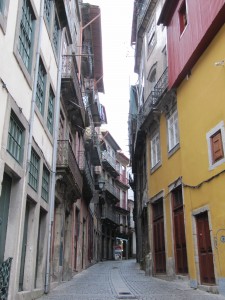 More and more buildings in Portugal are empty. Especially houses in city centres. This is something that Arrebita! Porto wants to change by adopting a social enterprise model. If the pilot project succeeds in Porto, where the problem is particularly bad, it could be a sustainable way out of the crisis for the whole country.
More and more buildings in Portugal are empty. Especially houses in city centres. This is something that Arrebita! Porto wants to change by adopting a social enterprise model. If the pilot project succeeds in Porto, where the problem is particularly bad, it could be a sustainable way out of the crisis for the whole country.
The streets that lead down to the banks of the Douro are flanked by old buildings. They form part of Porto’s Ribeira old town, a UNESCO World Heritage Site. There was a time when their colourful tiled façades sparkled in the sunshine and they were home to contented Portuguese people. But these days the paintwork is cracking on most of them, and more and more tiles are missing. There are fewer and fewer people living here in the centre of the country’s second biggest city. That’s why many windows are bricked up, closed with wooden shutters or even nailed up.
This is something that can be seen in countless Portuguese towns at the moment, despite the fact that many people urgently need somewhere to live during these times of crisis. But it’s in Porto that the situation is most critical: in the past two decades, the population of the city centre has shrunk by two-thirds. And everything suggests that it will continue to do so. “Nowhere else in the world have I seen so much empty property,” says the Portuguese architect José Paixão, who has spent half his life abroad. After going to school in the USA, studying in Austria and England, and working there and in Holland, he has now returned to Portugal to give something back to his homeland. “It became clear to me that something needed to be done about the increasing numbers of empty buildings and the decline of the cities,” says the 29-year-old.
Profit through an exchange of interests
So a solution had to be found which was both sustainable and had a social focus. Paixão got together with two friends and together they came up with the idea of applying the “exchange of interests” principle to their problem, which they knew about from Worldwide Organic Farms – farms where people work and, in exchange, live there for free. “When modernising buildings, that is a bit more complex, of course,” says Paixão. Nonetheless, he and his friend managed to develop a sustainable plan which involves little investment but from which everyone stands to profit.
What about the name, Arrebita! Porto? Translated literally, “Arrebita!” means something like “to pep up”, but for the project “bringing traditions back to life” would be more appropriate, according to Paixão. He and his friend took the expression from a Portuguese pop song. And the details of the project were to be as follows: young, international architects and engineers would survey all the buildings, draw up a plan of use and refurbish them with sustainable materials. The materials and expert support would come from partner companies. The whole project would be supervised by academic establishments. Everything would be agreed with the owners. The benefit for the architects and engineers would be a unique professional experience with a lot of practical knowledge; for the partner companies it would be an opportunity to raise their profile internationally; they could improve their image through taking on social responsibilities and there would be tax advantages too. For the academic institutions, it would offer a good opportunity for research and development, especially for case studies, and at the end the owners would get a newly restored building.
To spread the word about their idea and increase its credibility, in March 2011 they entered the competition “FAZ – Ideias de Origem Portuguesa,” which was launched by two recognised Portuguese foundations Fundação Calouste Gulbenkian and Fundação Talento. Four months later, they had the result: they had won the 50,000 euro prize. “It was immediately clear that we wanted to use it for the pilot project,” says Paixão. For this, there was to be a five-person team under his leadership, which would be replaced every three months. This was for two reasons: firstly because the participants would only get board and lodging but no fee, and also to incorporate as many different ideas as possible. And to get the most out of this idea, the members, according to Paixão, were to come from different countries. The first team came together quickly, and after the city of Porto made house number 42 in the narrow Rua da Reboleira available for them, which had been empty for almost 20 years as they had not been able to sell it, the pilot project started in April 2012.
Pilot project in Porto’s old town
“It’s a great experience that can’t be compared with anything,” says Filip Jovic, a team member from Serbia. “What’s more, we all bring different kinds of knowledge with us!” adds the Norwegian architect Ingrid Graendsen. But they are all agreed that the key thing, especially now at a time of economic crisis, is that the project can make an important contribution. “It is absolutely crucial to bring the cities back to life,” says Paixão, “to bring about a social change.” His team sees it in the same way and in particular supports the aspect of sustainability. “We ought to recycle more, and that also applies to buildings,” says Guido Crescentini Anderlini, an architect from Italy. “It is a new approach to a problem which no one in Portugal has so far been able to solve,” says the Portuguese participant Cristina Pinho.
And where does this problem actually come from? Why are increasing numbers of buildings empty? And why precisely in the city centres, which should really be natural focal points for people? In Portugal, it goes back a long way. For decades, there was no town planning. “After the revolution, the politicians concentrated on other things,” Paixão explains, “and the infrastructure was guided by power politics and not by the interests of the community.” Something else that exacerbated the problem of empty buildings was an especially Portuguese law, which outlawed the raising of rents in many buildings, as a result of which the owners had no money for maintenance and renovation. This led to many houses decaying. But the most important reason for most people leaving the town centres was that it was much more lucrative to construct new buildings in the suburbs rather than refurbishing the old buildings in the inner cities. That wasn’t at all sustainable, however, and Arrebita! Porto now wants to prove that there’s another way.
“We want to show that it’s possible to modernise buildings economically and by involving different players,” says Tiago Largo from the consultancy company NCREP. This is one of almost twenty businesses that Arrebita! Porto has meanwhile won over. Most of them are relatively new, but regard the crisis as an opportunity. They include both operational partners, who supply such things as wood, glass and tiles, institutional partners, who provide the international team with board, lodging and bicycles, as an environmentally friendly means of transport, and educational institutions, which support the project with expertise. The shared attitude gives them additional motivation: “Combining economics and sustainability,” says architecture professor Teresa Fonseca from the University of Porto.
Recycling buildings – a way out of the crisis
“This is the way we can take control of our own destinies,” enthuses Paixão. And that is quite literally what is now being done. After months of drawing plans, finding partners and developing ideas, and somewhat later than envisaged, more than six months after the start of the pilot project, the first restoration work began. “We are pleased that we now getting down to business,” says the Scottish engineer David Brownstein from the third international team to be working on the project.
The house should be finished by 2014. By then, the prize money will certainly have been spent. For that reason, and so that they are no longer dependent on sponsorship, the top two floors are to be rented out as apartments below market value. The ground floor and cellar will be available for the community and the creative industry, for example for start-ups or the workshops organised by Arrebita! Porto. The income from this as well as the rental commissions and advertising on the outside façades goes straight back into new Arrebita! Porto projects.
Because, if the pilot project goes as successfully as planned, the model should also be transferred to other buildings and cities in Portugal, according to Paixão. Through stimulating the cities, he hopes to create not just new places to live but also new jobs, by making it more attractive to invest there again and by tourism being boosted. That could lead to a long-term social transformation that significantly changes the living conditions of the Portuguese population, and thus creates a way out of the crisis.
Even though it hasn’t reached this stage yet, Arrebita! Porto has a good chance of keeping going even without public subsidies, because the number of its supporters is increasing which is mainly due to the fact that it coincides with the spirit of the future: recycling things together, as opposed to thoughtlessly throwing them away.
 Eco123 Revista da Economia e Ecologia
Eco123 Revista da Economia e Ecologia


